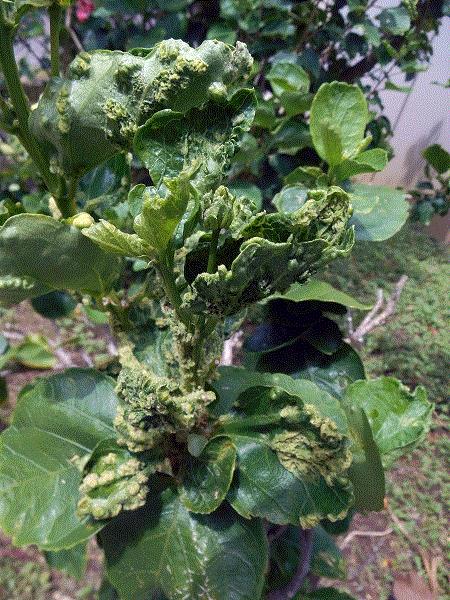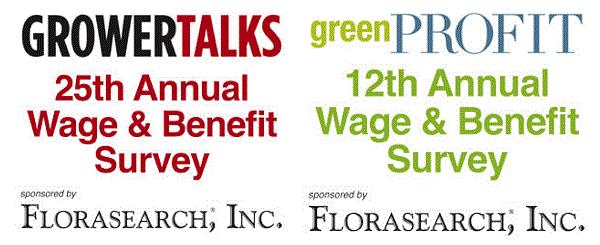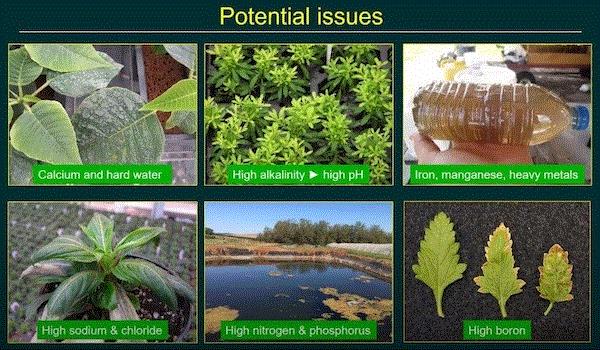What the … ?
Richard Criley is a world-renowned horticulturist from the University of Hawaii at Manoa. I have the honor of having him as a reader of this newsletter. A regular participant of my “What the … ?” game, Richard is turning the tables this week by providing a picture of a leaf gall on hibiscus. A very important hint for this “What the … ?” creature: It only occurs in Hawaii, the Caribbean, Australia, Brazil, Fiji, the Samoan Islands and Tonga.

What do you think this is? I know I’m giving those who travel to Hawaii on a monthly basis an unfair bias this week, but maybe I'm also torturing them by making them itch to go back?
(Answer at the end of this newsletter.)
V.I.S. 1 = Very Important Survey 1
I forget where and when, but someone told me that if you pepper your paper with abbreviations or acronyms, it makes people pay more attention to something they usually ignore. Why else do you think briefs coming from the official channels of our nation’s and state’s capitals require a law degree to decipher? So, I thought “V.I.S.” would get your attention and make you read on. Am I wrong to listen to that someone, whom may be my six-year-old nephew?
Y’all are already here; might as well read on because two very important surveys need your help!
The first survey is GrowerTalks’ and Green Profit’s annual Wage and Benefit Survey, sponsored by Florasearch. Can you believe it? This is the 25th annual grower survey and 12th annual retailer survey.

There are actually two surveys. If you are a grower, please click here to complete the grower survey. If you are a retailer, please click here to complete the retailer survey. The grower survey has 11 questions, and the retailer survey has 12 questions; all can be completed within five minutes, unless you have to carefully consider every single question and try to read between the lines. (Hint: There is nothing between the lines. And, GrowerTalks DOES NOT collect and sell your information.) The last question in both surveys asks you to provide an email address (if you want) so the nice people at GrowerTalks can send you a Yeti Tundra 45 Hard Cooler (if you win).
Click here for a summary of last year’s survey results. One theme in the 2019 survey that continued from previous years was a steady trend to increase staff numbers, but also a trend to increase salaries and benefits. It’s fun to read the list of advice survey respondents gave on attracting help. I thought my “you’ll work with bugs and ugly plants under the sun and be covered with sweat” speech helped me recruit employees over the years, but perhaps not? I’ll modify my speech with some of the speaking points in the summary.

V.I.S. 2 = Very Important Survey 2
Y’all perhaps notice by now that I rely quite heavily on the IR-4 Environmental Horticulture Program as my source of pesticide efficacy information. This pesticide efficacy data is generated (with support from IR-4) by researchers like me, and made freely accessible to users like you and me. I consider IR-4 as one of the most valuable and under-appreciated resources in our industry.
One of the major goals of the IR-4 Project is to facilitate the registration and expansion of pest management tools for specialty crops, including ornamental plants. These new registrations are supported by the crop safety, efficacy and residue data generated or collected by IR-4.

There are so many pests and diseases out there, so which one to focus on? IR-4 has only a little more than $500K for research annually, so the program has to target pest and disease problems that are impacting our industry. The way IR-4 determines the “most impactful species” is through the biennial Grower and Extension Survey. Doesn't matter whether you are a greenhouse grower or a municipal ground manager, y’all can participate in this survey and make your concerns heard. You have until July 31, 2021 to complete the survey online or by mail, but don't wait.
This survey has only nine questions, with three of them asking for your input on the weeds, diseases and insects that you think have few or no management tools for. The survey results will be summarized and shared with researchers and pesticide manufacturer representatives who attend the biennial priority setting workshop. Attendees of the meeting use the survey data to identify the national and regional focus pests for the next two years. (This year’s survey will gather information for the 2022-2023 cycle.)
The national targets for 2020 and 2021 are pythium, root and crown rots, borers, beetles, mealybugs, scale insects and nostoc, preemergent herbicide crop safety, and biopesticide efficacy against powdery mildew and root knot nematode. Regional targets include ambrosia beetle, root knot nematode, fatty acid herbicides, thrips, European pepper moth, bacterial leaf spot, post-emergent crop safety, glyphosate replacement, snails, botrytis and liverwort. These targets track pretty closely with their ranking in the 2018-2019 survey.
If you have specific products you or your company want to see registered for ornamental plants, let IR-4 know by completing the project request form. Click here to access the online form. Deadline for project requests is August 30, 2021.
Attendees at the priority setting workshop identify research targets by how important the pest problems are ranked by survey respondents and whether new products are available for testing. So, complete the grower needs survey or the project request form! If you want us to study snow mold control, let us know and get your buddies to complete the survey too!

Free education
I also heard that if you throw out the word “free,” you will also get more readers.
But, no joke, there are some free educational opportunities to be had.
Ball Tech On Demand is bringing technical training to you during this time of travel restrictions and conference cancellations. The In the Break Room series will be available every Tuesday and Thursday in October. With the slogan of “30 minutes for better spring crops,” the series provides short, timely training videos by experts on various technical topics, such as sanitation, plant nutrition, etc., to prepare you for the spring growing season. Click here for the series. The first two videos on “Starting strong with vegetative propagation” and “Training your team to water properly” are now available. I’m going to MAKE my team watch the watering training!

Paul Fisher of the University of Florida has made available a new YouTube video on how to sample, interpret and solve irrigation water quality issues in greenhouses and nurseries. Click here to access the video. Also check out the WaterQual tool to help interpret your water quality analysis results.

This is the first of the “Five Tips for Horticulture” video series from the Greenhouse Training Online Course. The upcoming videos will include topics such as growing media, vermicompost, and nutrient control in hydroponics.

Irrigation water quality and pest management
Y’all may read the news about a new video on interpreting irrigation water quality and wonder why I’d talked about it in a newsletter about pest management. That’s because, in my opinion, irrigation water quality is a factor that has not been carefully considered in many articles and presentations on pest management.
No, no, I’m not talking about dirty, untreated irrigation water carrying water-borne pathogens such as pythium, phytophthora, fusarium and thielaviopsis. We all know how important that is. R. Fischer and C. Powell talked about that in GrowerTalks 17 years ago (click to read Fischer’s and Powell’s archived articles), and we’re still talking about it. As long as we continue to draw and reuse water from collection ponds and other recycled sources, researchers and extension educators will continue to remind us of the importance of water treatment. (That makes you want to listen to someone harping about water treatment for decades to come, doesn’t it?) Click here to access the Clean WateR3 Team’s latest updates on water treatment technologies for greenhouses and nurseries.
Even if their spores aren’t carried by dirty irrigation water, diseases can still take the opportunity created by poor water quality to hurt your plants.
There aren't many studies examining the relationship between water salinity and disease prevalence in greenhouses and nurseries; most of the studies were conducted on field crops grown in irrigated arid-land. What little evidence we have points to a rather ugly picture for the plants and their disease susceptibility in an environment of high salinity. Increased water and soil salinity have been shown to increase both the severity of, and plant susceptibility to, fusarium, phytophthora and verticillium. (Likely for other root diseases too.)
Water salinity tips the balance towards pathogens because pathogens typically have higher salinity tolerance than their host plants. Water with higher salinity (that is, containing more dissolved salts or ions) disrupts the normal physiology and functions of plant cells, and damages roots. This gives pathogens more invasion sites and reduces the plant’s defense against diseases. Saline water also increases pathogens’ growth, sporulation and attachment to plant tissues, making them more virulent against a stressed and weakened host. Even fusarium-resistant tomato lines can be infected when the plants are grown in saline environments.
Water quality also influences pest management through its impact on pesticide degradation and longevity. Factors of particular importance in this respect are pH and turbidity.
Some pesticides break down quickly in alkaline water in a process called alkaline hydrolysis. Clay and organic matter in dirty water also bind some pesticide molecules tightly. Hydrolysis and binding make pesticide molecules unavailable to perform their intended functions. While most pesticides include a buffering agent that can help adjust pH and reduce the negative effects of alkaline hydrolysis, it’s still important to test for water pH and buffer the water before mixing whenever necessary. It would be important to think about filtration, treatment or pH adjustment if you have the same poor water source for pesticide mixing and irrigation. You certainly don't want to spray a compromised pesticide and not get the expected level of pest suppression.
Several years ago, Dara Park and I put together a short article explaining how water chemistry can influence pesticide efficacy. Click here to get a copy of the article. This article focuses on pesticide performance on turf, but it’s applicable to any crop system.
Answer to “What the … ?”
The leaf galls are hibiscus erineum galls caused by a tiny eriophyid mite species called the hibiscus erineum mite. Erineum mites are a large group of eriophyid mites that cause very fanciful galls on various plant species. Hibiscus erineum mite has a host species in hibiscus, and this is the first time I have seen their damage in a picture. Thanks for sharing, Richard!
We don't have hibiscus erineum mite in the continental United States. Who knows if it’ll show up in Florida or southern California when frequent travel between the mainland, Hawaii and the Caribbean resume. If you want to know more about the mite, check out this extension factsheet by Arnold Hara and colleagues.
See y'all next time!

JC Chong
Professor of Entomology at Clemson University
This e-mail received by 23,221 subscribers like you!
If you're interested in advertising on PestTalks contact Kim Brown ASAP!